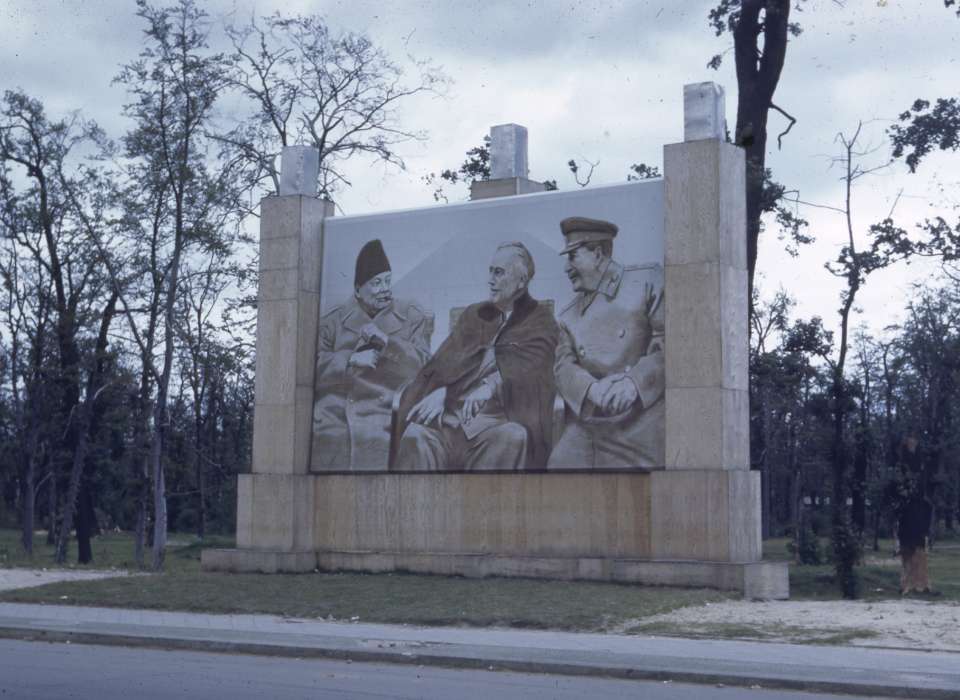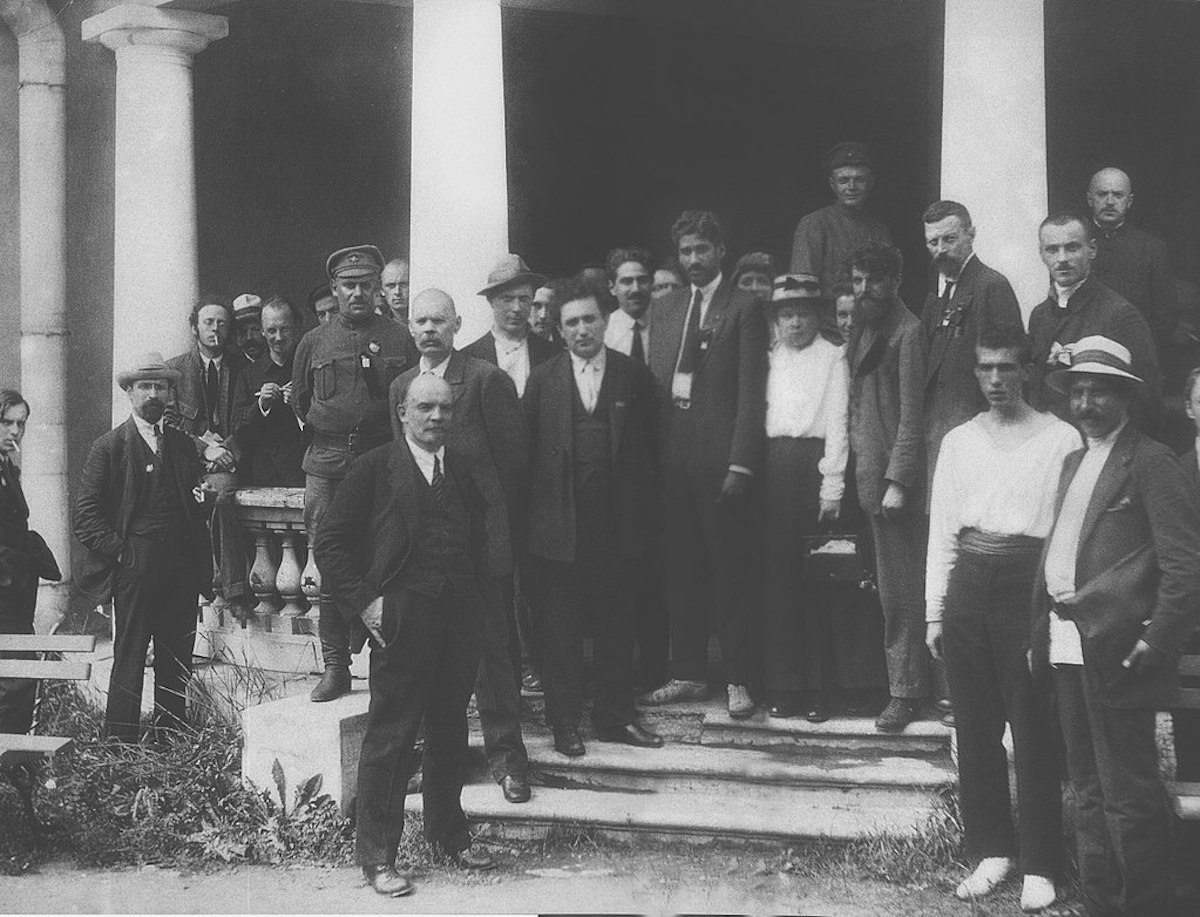Top image: Illustration with the Big Three (Winston Churchill, Franklin D. Roosevelt, and Joseph Stalin), Berlin, 1945. Gift of Bunzie Ellis Churchill, from the Collections of The National WWII Museum, 2012.333.038.
Three months after the titanic Soviet victory at Stalingrad and a mere week after German and Italian forces in Tunisia surrendered to the Allies, the Presidium of the Executive Committee of the Communist International announced an extraordinary resolution on May 22, 1943: The organization known to the world as the Comintern was dissolving itself. Led since 1935 by the Bulgarian-born Georgi Dimitrov, the Moscow-based organization called on its member parties around the world, many of them deeply involved in resistance activities against the Axis powers, “to concentrate their energies on the whole-hearted support of and active participation in the war of liberation of the peoples and the states of the anti-Hitlerite coalition for the speediest defeat of the deadly enemy of the working-class and toilers-German Fascism and its associates and vassals.”¹ After 24 years of existence as “the directing center of the international working-class movement,” the resolution read, the Communist (or Third) International terminated its sections’ “obligations arising from the statutes and resolutions of the Congresses of the Communist International.”²
Coming just as the course of World War II shifted in favor of the Allies, the appearance of the resolution might perplex 21st-century students of WWII history. Only six weeks after the decision, the Red Army would deal a crushing blow at the Battle of Kursk to Adolf Hitler’s hopes to regain momentum on the Eastern Front. Why would Joseph Stalin and the Comintern's leadership choose to disband the organization, the latter long an arm of the Soviet state, then? The resolution itself tendered a number of answers, answers intended to placate Communists in struggle around the globe.
The wording of the document was and still is a tutorial in Stalinist reasoning, in retrospect, bridging the gap in time between the advancement of Stalin's "socialism in one country" doctrine of 1924 and the notion of "national roads to communism" so prominent at the end of World War II. Invoking the “judgment of the founders of Marxism and Leninism” as a kind of holy writ, the resolution renounces any reliance on “organizational forms that have outlived themselves.” On the contrary, Communists subordinate “forms of organization of the working-class movement, and methods of working of such organization, to the fundamental political interest of the working-class movement as a whole, to peculiarities of the concrete historical situation and to problems immediately resulting from this situation.” Superficially read, the announcement defends a focus on the specific, concrete conditions Communist parties face where they are based and characterizes the International as an outdated institution. This is coupled with an emphasis on flexibility and autonomy for the Comintern’s respective sections. It is not coincidental that the statement references the Comintern’s Seventh Conference of 1935 as the genesis for this approach. That year saw Moscow favor the creation of People’s Front or Popular Front coalitions, with Communists cooperating with socialists (who had been seen as an even worse enemy than fascists from 1928-35) and even liberals to combat the spread of fascism. After the Seventh Congress, social revolution recedes dramatically as an aim behind the immediate goal of preserving bourgeois, i.e. parliamentary democracy, civil liberties, and the rule of law where they exist and fighting for their (re)creation in countries where the “Hitlerite bloc” dominates.
Furthermore, the nation becomes the singular focus of the international Communist movement. The May 1943, announcement elevates “deep differences of the historic paths of development of various countries, differences in their character and even contradictions in their social orders, differences in the level and the tempo of their economic and political development, differences finally in the degree of consciousness and organization of workers,” as well as “different problems affecting the working class of the various countries” into determining factors. Extreme variation in these developments from nation to nation works against overly uniform programmatic outlooks. “Any sort of international center would encounter insuperable obstacles in solving the problems facing the movement in each separate country,” the text insists.
Overall, then, the resolution seemingly and misleadingly indicates that a new openness, flexibility, and independence will define the relationship between Moscow and the Communist Parties. National peculiarities assume prominence, with the immediate objective of toppling fascism crowding out everything else. Anti-fascist unity, built on accepting men and women, “without difference of party or religion in the ranks of the powerful anti-Hitlerite coalition,” clearly demonstrates, the message goes, “the general national uprising and mobilization of people for the speediest victory over the enemy can be best of all and most fruitfully carried out by the vanguard of the working-class movement of each separate country, working within the framework of its own country.” What could be objectionable for left-wing militants about such an objective and perspective?
It is most revealing that the resolution, while mentioning the creation of the Comintern in 1919, omits so much of the politics of the 51 delegates from the more than two dozen countries who founded the Third International during five days of sessions in March of that year. Doing terrible violence to that history, the resolution recounts three original goals for the new International: 1. “consolidation in a number of countries of the vanguard of the foremost workers in the real working-class parties”; 2. “helping them mobilize workers for the defense of their economic and political interests”; 3. “the struggle against Fascism and the war which the latter was preparing, and for the support of the Soviet Union as the chief bulwark against Fascism.”
Glaringly absent in the 1943 statement was Vladimir Lenin’s contention in 1919 that the movement of events is on the side of “the workers’ revolutionary movement, and that the world revolution is beginning and growing in intensity everywhere”; the Comintern’s explicit demand for all power to workers’ and soldiers’ councils (known as “soviets” in the Russian context); and the advocacy of radical internationalism to counter the national chauvinisms that had contributed to the outbreak of World War I.³ All of these ideas were fundamental to the Third International in its early years. Neither of course are the names of Grigory Zinoviev, the first chairman of the Comintern and the architect of its debilitating "Bolshevization" in 1923-25, Nikolai Bukharin, Zinoviev’s successor, or Leon Trotsky, who was a key participant in its activities and wrote extensively about it, cited anywhere. Stalin had had all three murdered: Zinoviev in August 1936 and Bukharin in March 1938, after show trials, and Trotsky in August 1940. The silences in the resolution speak as loudly as the printed passages. Murders of old Bolsheviks—and with them their politics—are crucial subtexts of the statement dissolving the Comintern.
Finally, fascism, whether in Italy or Germany, hardly posed a major problem for the revolutionary Left in Europe in 1919. Although vicious counterrevolution was a serious threat (the murders of Rosa Luxemburg and Karl Liebknecht in Berlin during the misnamed "Spartacus Uprising" are glaring examples), Fascist organizations numbered in the dozens or hundreds at this point. It would be a few years before the Comintern, under Zinoviev, fully addressed the menace to Marxist politics created by the ex-socialist Benito Mussolini’s rise. Even then, however, anti-fascism did not define the politics of the Third International until the Seventh Congress, after Hitler assumed power in Germany. Thus, the 1943 resolution attempts to rewrite the history by chopping off much of what actually transpired prior to the era of the Popular Fronts.
Little of this mattered to Joseph Stalin in May 1943. He had not the slightest intention of really relinquishing Soviet control over the Communist Parties. What he realized was that the gesture of eliminating the Communist International would buy him not only good will with the Western Allies but much needed American matériel. US diplomat Joseph Davies, former ambassador to the USSR and author of the controversial Mission to Moscow (turned into a movie in 1943), arrived in the Soviet capital just three days before the Stalin regime proclaimed the Comintern’s end. As Isaac Deutscher, a supporter of Trotsky, put it in one of the first scholarly biographies of Stalin: Stalin “studiously cultivated the appearance of a single anti-fascist interest and democratic ideology, common to the whole coalition. To that appearance he sacrificed the Comintern, when, in May 1943, he decided to disband it. This was his political contribution to the coherence of the Grand Alliance.”⁴
It should not be overlooked how Winston Churchill, a most visible and vocal anti-Communist, reacted to Stalin’s decision. He welcomed the news of the dissolution of the Communist International, describing the Soviet action as “very fine and full of hope for the future.”⁵
In retrospect, with an eye to Stalin’s hostility toward grassroots revolution, actual autonomy for leftist parties, and independent Marxist thought, as well as his firm embrace of the nation and national difference as major arbiters for political, social, and economic action, the breaking up of the Communist International does not actually shock. It should be understood not only as an act intended to placate the Western Allies. Rather, it was also perfectly consistent with the counterrevolutionary politics the dictator had touted and imposed wherever possible in the two decades before 1943.
¹ https://soviethistory.msu.edu/1943-2/end-of-the-comintern/end-of-the-comintern-texts/dissolution-of-the-comintern/. All further references to the resolution stem from this linked document.
² The First International, of which Karl Marx and Friedrich Engels were central figures, lasted from 1864-1876; the Second International, founded in Paris in 1889 on the centenary of the French Revolution, collapsed in 1914 when socialist and labor parties sided with their respective governments as World War I began.
³ Vladimir Lenin, “Opening Remarks” (March 2, 1919), in Founding the Communist International: Proceedings and Documents of the First Congress, March 1919, ed. John Riddell (New York: Pathfinder Press, 1987), 71-72.
⁴ Isaac Deutscher, Stalin: A Political Biography, 2nd ed. (New York: Oxford University Press, 1966), 475. Deutscher’s pathbreaking biography was originally published in 1949.
⁵ Quoted in David Reynolds and Vladimir Pechatnov (with the assistance of Iskander Magadeyev and Olga Kucherenko), eds., The Kremlin Letters: Stalin’s Wartime Correspondence with Churchill and Roosevelt (New Haven: Yale University Press, 2018), 254.
Jason Dawsey, PhD
Jason Dawsey, PhD, is ASU WWII Studies Consultant in the Jenny Craig Institute for the Study of War and Democracy.
Cite this article:
MLA Citation:
APA Citation:
Chicago Style Citation:






![Max Fuchs, New York City cantor, sings as Rabbi Sydney [sic] Lefkowitz, Richmond, VA, conducts the first Jewish services from Germany.](/sites/default/files/styles/max_650x650/public/2025-10/image1.jpg)



